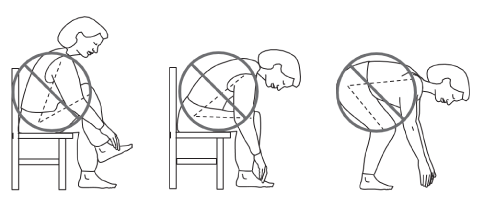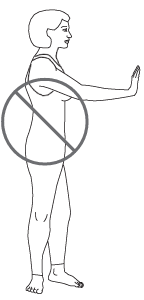Your surgeon will leave an order about how much weight you can put on your repaired hip (weight bearing status). Don’t put more weight on the side that was fixed than your surgeon, nurse, or therapist say you can.
Depending on what surgery you had, you may have some movement precautions (the “Do Not’s”). As you move around the nursing unit, you’ll be reminded how to move to protect your hip.
These are the 3
movement precautions (the “do nots”) for your hip:
- Do not bend your hip more than 90 degrees.
- Do not twist your body.
- Do not cross your legs or your ankles.
These pictures show the right way to sit in a chair:
- sit straight
- keep your legs uncrossed
If you had a partial or total hip replacement, do not do any of the following movements for at least 3 months after surgery.
DO NOT bend your hip more than 90°:

Do not bring your knee higher than your hip
Do not reach forward towards your feet.
Do not reach down for objects on the floor.
Do not twist your body.

This means:
- not reaching across your body. Tip: organize your things so that you can easily reach them.
- making sure to take small steps when you’re turning
- keeping your shoulders and hips in line at all times and not twisting your leg inwards or outwards
Do not cross your legs or your ankles:
- Crossing your legs or ankles could cause your hip to dislocate
- Putting your ankle up on your knee or thigh could also cause your hip to dislocate.
- Always use a pillow between your legs when lying in bed.
- You can lie on the side that’s more comfortable.


